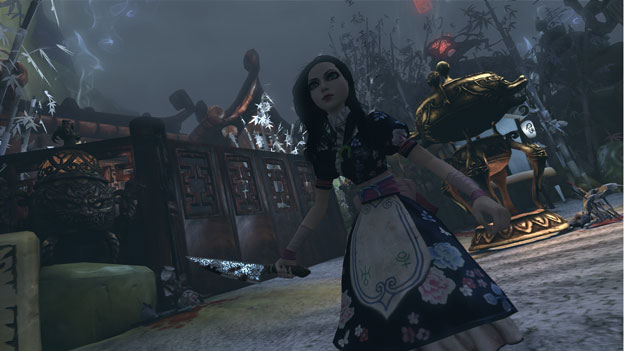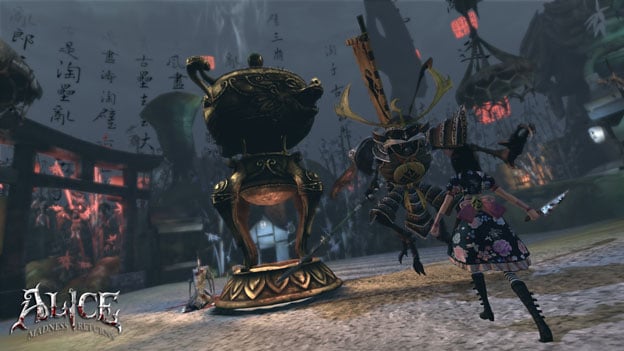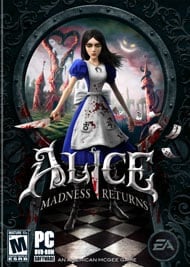Back Down the Rabbit Hole
Since it’s been eleven years since American McGee’s Alice was released, I wasn’t sure what to expect when I booted up Madness Returns. Would it be a horrifying adventure filled with terrifying creatures and limited health? Or maybe it would be more of an action adventure game with clever puzzles and solid platforming? Well, it has elements of both, but in the end it’s really none of the above.
Madness Returns is an interesting beast. It’s obvious that a lot of effort, love, and dedication were invested into building an experience that is as beautiful as it is frightening. The team at Spicy Horse has made one of the most unique games I’ve had the pleasure of playing in a long time, but unfortunately there are a few issues that keep this game from being the follow-up many of us so desperately wanted it to be.

Let’s start with one of the game’s best features: the art style. This definitely won’t stand up to the better-looking games out there, and there are a handful of graphical issues like slow-loading textures and noticeable seams. But it’s evident that quite a bit of time was taken to make sure each of the game’s six levels looks different than the next, and each new level brings with it a completely different aesthetic with new creatures, both good and bad—terms I’ll use loosely—to inhabit it. The only issue is that while each environment looks different, they each play almost exactly the same. You have the geysers that lift you high into the air, pads on the ground for you to bounce on so you can get to those hard-to-reach places, and enemies that look different but require similar strategies to vanquish as their siblings in the other worlds.
Basically, you can break Madness Returns into three sections: combat, platforming, and puzzles. Sadly, the only section that requires any real effort is the combat, and that’s only when you’re forced to fight a large number of adversaries at once. The platforming, for the most part, is pretty basic. You jump and float from one area to the next, using the geysers and jump pads that have been strategically placed to help you. Occasionally you’ll come across invisible platforms that require a little more effort to cross.

Early in the game, Alice gains the ability to shrink herself so she can walk through small keyholes near the ground that lead to hidden items like collectible bottles, memories, or teeth, the game’s currency. This ability also comes in handy for revealing the invisible platforms that can only be seen when Alice is very small. These help to break up the otherwise monotonous platforming, but they’re never really used to their full potential, and they’re almost always easy to get past.
The puzzles, though few and far between, are also very simple. For example, there’s one puzzle that has you gather cubes strewn about the environment that act as pieces of a sliding puzzle. There are also targets that must be shot to reveal hidden platforms and pressure plates. Alice can stand on these or place a timed bomb on them before quickly scurrying to the next area. If the bomb explodes before you finish, everything resets and you must start over. The puzzles are fun, but never require much time to figure out. Once you’ve successfully completed them, there’s no real feeling of accomplishment.

The combat is one of the most important pieces of the game, since you’ll be fighting enemies as often as you’ll be traversing aerial platforms. There will be a variety of enemies thrown at you over the course of the game, but you’ll soon come to realize that while an enemy might look unique, it can usually be dispelled using the same technique used on a similar enemy in a previous world. Essentially, there are only a handful of different foes that are just wearing different skins.
With that said, the combat is actually very satisfying. Switching between weapons is a breeze, mainly because there are so few to choose from, and striking enemies with any of the game’s four weapons feels powerful. This becomes especially true as you start using the teeth you’ve collected to upgrade your arsenal. There are two close-ranged weapons: the Vorpal Blade is a quick and deadly knife, and the Hobby Horse is a defense-smashing hammer. The two ranged weapons are the Pepper Grinder, which is basically a machine gun, and the Teapot Cannon, which is exactly what it sounds like—a defense-breaking cannon.

The constant platforming, combat, and puzzle-solving are sometimes broken up by the random unexpected segment of gameplay. Seemingly out of the blue, you’ll be asked to play a tune like you’re performing a track in Guitar Hero, slip down long slides covered by groups of deadly obstacles, or fight off sharks and crabs with cannon arms as your ship dives deep below the sea. You’ll even get to do some of your platforming in a gorgeous 2D envisioned Wonderland. For me, these 2D areas were the most memorable parts of the game, and they broke up the repetitive gameplay very well. The only problem is they’re too few and far between.
One of the game’s strongest assets is its sound design. The music varies from one level to the next; it’s a beautiful distraction when it needs to be and provides an epic backdrop to the fight sequences. The voice work is just as strong as the well-written dialogue, and both come together perfectly to make the characters that inhabit Wonderland feel alive. I found myself grinding through the platforming sections just so I could get another piece of the story, meet an interesting new character or watch one of the game’s many stunning cinematics.
In the end, Alice’s second trip into madness isn’t quite as satisfying or fresh as her first. Everything feels dated and there’s an unfinished, even hurried quality to the game that’s more than a little disappointing. That doesn’t mean there’s a shortage of great moments or fantastic ideas, because Madness Returns has both in spades. It’s just that the overall experience is bogged down by slow pacing, repetitive gameplay, and visuals that could’ve used a little more work. But if you’re looking for a fun, unique adventure filled with beautiful worlds and entertaining characters, Madness Returns won’t disappoint.
RATING OUT OF 5 RATING DESCRIPTION 4.0 Graphics
Aside from a few graphical hiccups like texture-popping and a few very noticeable seams, the game looks good and its unique art style helps to set it apart. 3.8 Control
The combat is satisfying, if not a little too basic, and switching between weapons in the heat of battle is easy. However, Alice can feel unresponsive during the platforming segments and the camera can be frustrating at times. 4.8 Music / Sound FX / Voice Acting
The soundtrack and voice work are fantastic. The music is beautiful and haunting, and because of the incredible dialogue, the characters really come to life. 3.5 Play Value
The campaign is fairly meaty and offers a few reasons to return for those who like to collect all of the game’s hidden items, but the repetitive gameplay will keep many from wanting to play through it again. 3.9 Overall Rating – Good
Not an average. See Rating legend below for a final score breakdown.
| Review Rating Legend | |||
|---|---|---|---|
| 0.1 – 1.9 = Avoid | 2.5 – 2.9 = Average | 3.5 – 3.9 = Good | 4.5 – 4.9 = Must Buy |
| 2.0 – 2.4 = Poor | 3.0 – 3.4 = Fair | 4.0 – 4.4 = Great | 5.0 = The Best |
Game Features:
